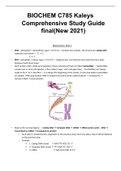BIOCHEM C785 Kaleys
Comprehensive Study Guide
final(New 2021)
Biochemistry: Mod 1
• DNA = phosphate + deoxyribose sugar + A/T/C/G o Contains two strands. The strands are antiparallel
(opposite each other). o 5’ → 3’
3’ ← 5’
• RNA = phosphate + ribose sugar + A/U/C/G o Single strand, can fold back onto itself and form pairs
between itself (stem‐loop).
• Each nucleic acid is made up of polymers (many monomers) that are called nucleotides. o Nucleotides
contain one or more phosphates, a five‐carbon sugar, and a nitrogen base. o Nucleotides are always
made in the 5’ to 3’ direction. o 5 is always the beginning of the strand, 3 is the end where nucleotides
are added. DNA organization: DNA is wrapped around proteins called histones → nucleosome →
chroma n fiber→ chromosomes
• Steps to the central dogma: o Coding DNA → template DNA → mRNA → tRNA (amino acid) o DNA →
transcribed to mRNA → translated to protein
o Each step is complementary (opposite) to the previous step, but if you skip a step it will be identical
to the previous step.
o Example
1. Coding DNA strand 5’ AAA TTT GGG CCC 3’
2. Template DNA strand 3’ TTT AAA CCC GGG 5’
3. mRNA 5’ AAA UUU GGG CCC 3’
, 4. tRNA Lys Phe Gly Pro
• Pairing: o DNA: A → T o RNA: A → U
• DNA replication: o Because DNA is a double helix, one strand can be separated and serve as a template
for synthesis of a new strand. o Semi‐conservative: each copy of DNA contains a template strand and
a new strand. o Steps of replication:
o 1. The DNA must be separated, creating a replication fork. This is done by helicase. o
2. Primase attaches an RNA primer, where the replication is to start.
o 3. DNA polymerase adds bases to the remaining of the strand until it reaches a stop
codon. This is done in fragments, called okazaki fragments.
• If an error is detected, it removes the nucleotides and replaces them with correct ones, known as
exonuclease.
o Exonuclease removes all of the RNA primers, and DNA polymerase fills in those gaps. o
DNA ligase seals the two strands forming a double helix.
• DNA → transcribed → mRNA → translated → protein
• Transcription occurs in the nucleus: o Initiation: RNA polymerase binds to a sequence of DNA called
the promoter, found near the beginning of a gene. Each gene has its own promoter. Once bound, RNA
polymerase separates the DNA strands, providing the single ‐stranded template needed for
transcription.
,
, o Elongation: One strand of DNA, the template strand, acts as a template for RNA polymerase. As it
"reads" this template one base at a time, the polymerase builds an RNA molecule out of
complementary nucleotides, making a chain that grows from 5' to 3'. The RNA transcript carries the
same information as the non‐template ( coding) strand of DNA, but it contains the base uracil (U)
instead of thymine (T).
o Termination. Sequences called terminators signal that the RNA transcript is complete. Once they are
transcribed, they cause the transcript to be released from the RNA polymerase.
o
Pre‐mRNA must go through extra processing before it can direct translation.
• They must have their ends modified, by addition of a 5' cap (at the beginning) and 3'
poly‐A tail (at the end).
• Pre‐mRNAs must also undergo splicing. In this process, parts of the pre‐mRNA
(called introns) are chopped out, and the remaining pieces (called exons) are stuck back
together.




